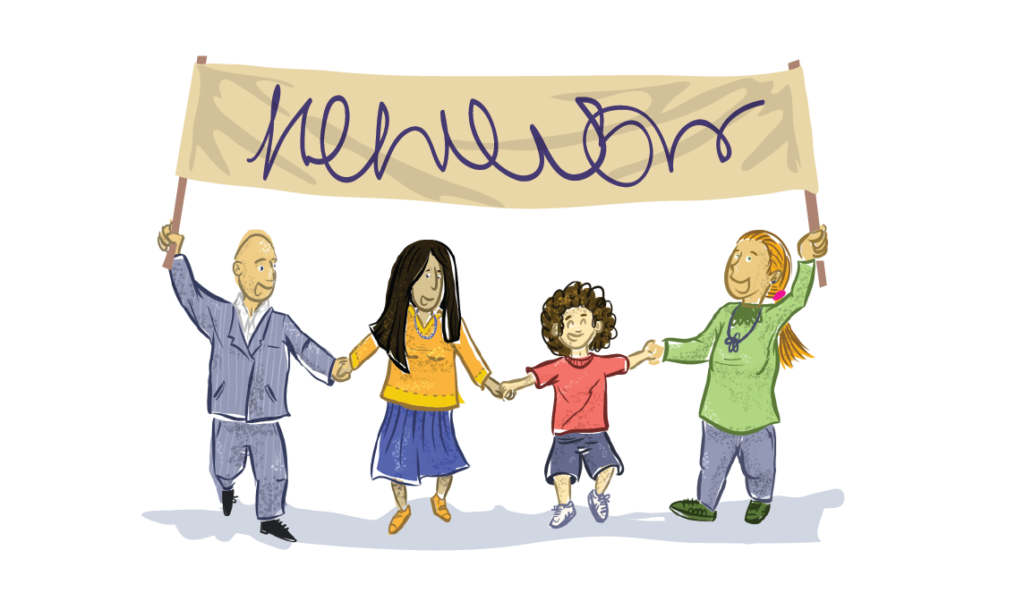Inclusiveness of my Human-Rights-Based School
Living Democracy » Principals » HUMAN RIGHTS BASED SCHOOL » Inclusiveness of my Human-Rights-Based SchoolAwareness
Like other heads of schools, you know and have heard and read it hundreds of times: Education has been recognized as a human right in numerous important international conventions.
In particular, the United Nations Convention on the Rights of the Child (CRC) references the rights of children under 18. It recognizes education as a legal right and equal opportunity for every child. Its Article 28 guarantees free compulsory primary education for all, progressive free secondary education that should, in any case, be available to all, as well as accessibility to higher education in terms of capacity. It states the obligation of the State to adopt measures regarding school attendance and discipline while protecting the children’s dignity. It encourages international cooperation in terms of education, particularly the elimination of ignorance and illiteracy and promotes access to scientific and technical knowledge.
Its Article 29 defines the aims of education and, recognizing the individuality of children, recommends that education should be directed towards every child’s personality, talents, and abilities.

On the whole, apart from the provisions concerning access, the right to education encompasses the obligations of the States to refrain from discrimination at all levels of the educational system, and to set minimum educational standards to improve the quality of education.
And now: you are the head of your school. You have limited resources, and you are faced with the daily routines and the daily problems to solve. To ensure the basic functioning of the school by itself is a huge task. Additionally, you must maintain a welcoming and nurturing environment and educate all students regardless of their sex, physical, intellectual, social, emotional, linguistic, or other individual characteristics. Your school must be an inclusive institution, which is the law in many countries. What a task!
You are responsible to ensure that all school staff respect and promote diversity and equal opportunity for all. Moreover, you wish that everyone treat diversity as an opportunity and not as an obstacle to quality education.
But where do you stand in this respect? What are your own memories when it comes to inclusion? Have you ever personally experienced a moment of exclusion? Were you always the successful student, teacher, and head of school who raised awareness when others were not included? It would be worthwhile to critically review this matter and to self-assess your own situation, experience, and values. Will you only initiate an action when you fully agree to support all involved in taking this action together with you? In so doing, you provide others with a first-hand experience of inclusion and evidence of how intensively an HRBS is engaged in practical changes so that all students can succeed – regardless of their background or skills and competences.
Experience shows that these changes will be to the advantage of all students in your school in that they support quality teaching and learning for all. Furthermore, it is not only the students who benefit – everyone else will feel included. In an inclusive micro-society that embraces parents, teachers, school staff and administrators, the board and everyone in the community will be collaborating with your school. Are you ready for this adventure?
More importantly, your teachers need to have or develop a broad understanding of inclusion. In meetings together with your specialists (school pedagogue, psychologist, or teachers with additional training in this field) you must find ways to support your teaching staff in this development.
First, everyone concerned must have a basic understanding of inclusiveness. The following might help to clarify the concept.
Inclusion in education is more than what many think it is!
https://inclusiveeducation.ca/about/what-is-ie/ August 18, 2020.
|
Since its initial conception in the early 20th century, and until quite recently, ‘inclusive education’ was construed as ‘including students with disabilities’ or ‘special learning needs’ in mainstream classroom instruction. Many still understand the term along these lines. However, inclusive education means that all students attend, and are welcomed by, their neighborhood schools in age-appropriate, regular classes, and are supported to learn, to contribute and participate in all aspects of school life. Inclusive education is about how we develop and design our schools and our programs and activities, so that all students can learn and participate together. Inclusive education is about ensuring access to quality education for all students by effectively meeting their diverse needs in a way that is responsive, accepting, respectful and supportive. Students participate in the education program within a common learning environment with support to diminish and remove barriers and obstacles that may lead to exclusion. Inclusive education is carried out in a common learning environment, an educational setting where students from different backgrounds and with different abilities learn together in an inclusive environment. Common learning environments are used for most of the students’ regular instructional hours and may include classroom, library, gym, theatre and music room facilities, cafeterias, playgrounds, and the local community. Thus, a common learning environment is a place where students with intellectual disabilities or other special needs can learn together with their peers, rather than separately. Effective common learning environments:
Ensuring that each individual child has an equal opportunity for educational progress remains a challenge worldwide. Sustainable Development Goal 4 on Education and the Education 2030 Framework for Action emphasize inclusion and equity as laying the foundations for quality education. |
For this task of making your school a model for inclusive education, you must have many colleagues in the same boat right from the beginning. With your team, you would need to develop a plan on how to get a better understanding of your school’s situation by integrating as many stakeholders as possible in this process.
Preparation
What steps to take?
- Form a team to work with during the whole process. Together with your team, start by discussing the approach and consider the list of indicators.
a. Choose the important ones for your school.
b. Add any indicators you feel are missing.
c. Fill in the form with about ten indicators you find important. Be sure to choose some indicators where you do well and some you where you need additional development. - With your team, prepare an action plan and a time frame for a first assessment, which will be the starting point for the further development. Include in the assessment:
a. Pupils
b. Teachers
c. Other school staff
d. Parents
e. School board
f. Members of the community with whom you may be cooperating
g. … - Develop the action plan and the time frame. Make sure, they include
a. The school’s profile after the first assessment.
b. Steps to undertake (in the next 6 months).
c. A second assessment to learn about the developments.

25 possible indicators for your school to assess your inclusiveness:
- The school has a mission and/or a vision statement and policies about inclusive, human-rights-based education, including a policy against discrimination.
- Teachers can understand and explain the full meaning of ‘inclusive education’ (beyond students with disabilities or special learning needs).
- All students who reside within the school’s jurisdiction attend the school unless the parents have elected to send their child to a private or other school (where applicable).
- All students are assigned to their age-appropriate grade.
- The school and its facilities are physically accessible to all students.
- The school knows which professional organizations, paraprofessionals, advocacy groups, and community organizations may offer resources for inclusive education that will benefit students of diverse backgrounds and abilities.
- The school uses several types of student assessments and does neither assess students based on performance tests nor publicize their results.
- The school has measures in place for assisting students with disabilities and/or special needs, particularly in terms of their protection and providing for their learning (e.g., Braille materials, deaf signers, multilingual resources).
- Teachers visit ‘model schools’ and/or attend workshops on developing an inclusive classroom and school. Thus, they receive advanced professional training on a regular basis to develop the requisite knowledge, skills, and attitudes for meeting their students’ needs in mainstream classrooms in an inclusive way.
- Parents and community groups are familiar with inclusive education and offer ideas and resources to assist the school in becoming more inclusive.
- The school demonstrates in specific ways that its administrators and teachers understand the importance of inclusive education (such ways include mechanisms for guaranteeing access to school by all students regardless of their background or ability).
- The school has (or plans to develop) a diverse school staff (comprised of women and men of different backgrounds in terms of race, ethnicity, physical ability, religion, language, socio-economic status, etc.). In countries where teachers are appointed to schools by the State, based exam scores, etc., the school takes advantage of the diverse elements its staff brings with them.
- The school shows respect for students of all religions; students have opportunities to learn about different religions and belief systems, as appropriate, in school.
- The school has a steady supply of clean, drinking water and serves or sells healthy, nutritious, and high-quality food/snacks while accommodating and respecting the dietary rules of different religions.
- Teachers set high expectations for all students, regardless of their background or ability, and encourage them to complete school.
- Teachers are aware of resources that are available to assist students with special needs including special learning needs.
- All students have textbooks and learning materials that match their learning needs.
- Learning activities take place in multiple formats such as individual, pairs, small group, and whole class instruction in which heterogeneous student groups are ensured.
- Students are given the opportunity to learn their mother tongue while they are mastering the official language(s) of instruction.
- All students contribute to the development of guidelines and rules for their classroom and school to foster inclusion, non-discrimination and prevent violence and abuse.
- The learning and teaching processes, as well as the learning materials engage the students in a balanced and non-discriminatory manner, regardless of their background or ability.
- In the learning materials provided by the school, children of diverse backgrounds and abilities are portrayed positively. The students understand the concept of inclusive education and can identify cultural, religious, ethnic, gender and other bias in learning materials.
- Students with physical disabilities have opportunities for physical play and development.
- The school culture encourages cooperation and teamwork among teachers, other school staff, the students, parents, and members of the community when needed.
- Students and parents participate in decision-making.
Action
With your team, select 10 indicators from the list.
| Chosen indicators for inclusion | Status of this indicator in my school from 1 to 10. | Steps to be taken (collected by the discussion teams). |
| 1. | ||
| 2. | ||
| 3. | ||
| 4. | ||
| 5. | ||
| 6. | ||
| 7. | ||
| 8. | ||
| 9. | ||
| 10. |

- Based on the list above, prepare a handout or flipcharts to be given to all stakeholders included in the assessment process.
- Form roundtables with the different stakeholders (pupils, teachers, staff members, parents, board members, etc). They latter may meet on the occasion of a big school event, or scheduled meetings, according to their availability.
- Ask them to discuss their assessment and their comments.
- Task them to come up with proposals for improvement.
- Collect all comments and proposals in your team.
- Devise a clear and actionable master plan for the coming 6 to 12 months.
- Report the masterplan to all key players involved.
- Plan the next assessment period (Transparency comes first!).

